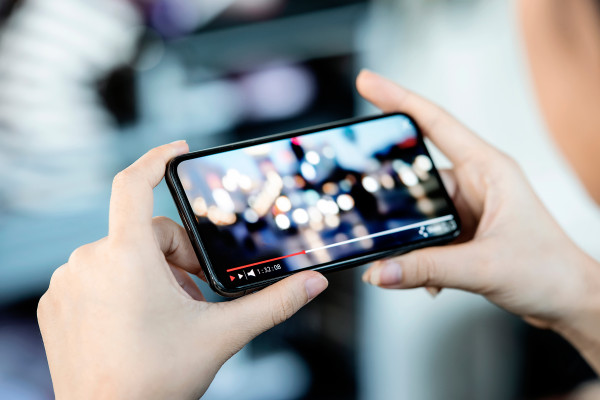
The Art of Digital Storytelling
Gone are the days when storytelling was limited to just words or pictures; today, anyone with a smartphone can create videos to tell their story. In this blog, we’ll share some tips on how to ‘digitally story-tell’ like a pro.
Choose Your Story
Every great video starts with a compelling story. It could be a personal experience, a travel adventure or a do-it-yourself (DIY) project … whatever it is that you’re passionate about. Remember that a good story is the heart of any great video.
Mastering Smartphone Videography Techniques
Before diving into the world of digital storytelling, it's important to understand the basics of mobile phone videography. Phones come equipped with advanced camera features, but knowing how to make the most of them can significantly enhance the quality of your videos:
Framing and Composition:
- Pay attention to framing by using the rule of thirds. Divide your frame into a 3x3 grid and position your subject along the lines or at the intersections for a balanced composition.
- Experiment with different angles, such as eye-level, high-angle, and low-angle shots, to add variety to your videos.
Lighting Matters:
- Natural light is your best friend when shooting videos. Whenever possible, film in well-lit environments, and avoid harsh direct sunlight.
- If shooting indoors, use soft, diffused lighting to reduce shadows and create a flattering look for your subjects.
Steady As You Go:
- Stabilize your shots by using a tripod or handheld gimbal. Smooth camera movements can make a big difference in the overall quality of your videos.
- Alternatively, you can improvise with DIY stabilization techniques, like using a rubber band to secure your phone to a stable object.
Don’t Forget about Audio:
Great video isn't just about what you see; it's also about what you hear. Poor audio quality can ruin an otherwise fantastic video:
- Use an external microphone if possible. There are affordable options available that will make a big difference to your audio quality.
- Avoid recording in noisy environments, as background noise can be distracting. Find a quiet space or use noise reduction features available in some video editing apps.
Editing Magic: Transforming Raw Footage into Stories
Once you've captured your video footage, it's time to dive into the world of video editing. There are numerous video editing apps available for both iOS and Android devices. Some popular options are Adobe Premiere Rush, iMovie, Kinemaster, and FilmoraGo. Have a search and find one that suits your style and needs.
Editing Your Video
Now for the all-important editing process:
- Importing Footage: Start by importing your video clips into the editing app. Most apps allow you to import clips from your phone's gallery or directly from the camera.
- Arranging Clips: Organize your video clips in the desired sequence to create a coherent narrative. Trim unnecessary footage and ensure a smooth flow.
- Adding Transitions: Use transitions like cuts, fades, or wipes to connect your clips seamlessly. Transitions can help maintain viewer engagement.
- Music and Sound: Select background music that complements the mood of your video. Adjust audio levels to ensure that music and voiceovers are balanced.
- Text and Titles: Add text overlays or titles to provide context or guide the viewer through your story.
- Special Effects: Depending on your editing app, you can incorporate special effects like filters, colour grading, and animations to enhance your video's visual appeal.
- Export and Share: Once you're satisfied with your video, export it in the format you need and share it with your audience.
The Elements of Storytelling
While editing your video, remember these pro-tips:
A Strong Beginning: Grab your audience's attention right from the start. You can use an intriguing question, a striking image, or a brief teaser to grab their interest.
A Clear Narrative Arc: Your video should have a clear structure, with a beginning, middle, and an end. Introduce the conflict or theme, build tension, and provide resolution or insight.
Emotional Connection: Engage your audience emotionally by including relatable characters or situations. Emotion is a powerful storytelling tool.
Sharing Your Creations with the World
Once you've crafted your video masterpiece, it's time to share it with the world. Here are some strategies for sharing your videos:
Choose the Right Platform: Consider where your target audience spends their time online. YouTube, Instagram, TikTok, and Facebook are popular platforms for sharing videos, each with its unique audience.
Optimise for Mobile viewing: Most viewers will watch your videos on mobile devices. Ensure that your videos are optimized for mobile viewing with clear visuals and legible text.
Engage with your Audience: Interact with your viewers by responding to comments, asking for feedback, and building a community around your content.
Collaborate and Network: Collaborate with other content creators or influencers in your niche to expand your reach and gain new followers.
Digital storytelling through videos is not only a great and engaging way to share a point of view, but it’s also a load of fun! Experiment with different storytelling techniques, editing styles, and genres to find your unique voice as a digital storyteller.
So, what story will you tell today?

